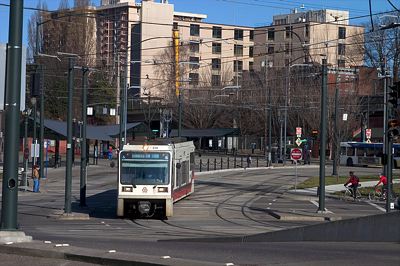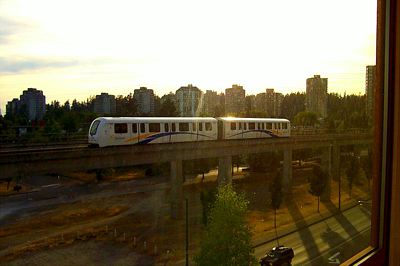Randy Gragg, the architecture critic for the Portland Oregonian, thinks that Portland “lacks a coordinated transportation plan” and needs a “grand vision” to deal with transportation in the future. In fact, what Portland needs is to deal with the reality of how people really live, not a vision for how some people think everyone else ought to live.
In 1992, Portland-area voters decided to create Metro, a regional planning agency that would create a vision for Portland’s future and implement that vision through land-use and transportation planning. Now, after fifteen years of expensive planning and increasing congestion, Gragg is effectively saying that Metro has failed.

Portland light rail and mid-rise development. Flickr photo by ahockley.
On that point, I fully agree. But while Gragg seems to think that the solution is a multi-billion-dollar investment in more light-rail and high-rise developments, in fact we have enough experience by now to say for certain that this is entirely the wrong course for the region.
Unfortunately, Gragg’s May 20 Sunday Oregonian article is not (yet?) available on line. But, as examples of “vision,” Gragg points to Denver, which approved a $4.7-billion plan for “119 miles of commuter and light-rail lines”; Houston, which approved “73 miles of light rail and regional commuter trains”; and Phoenix, which approved a transportation plan with “27.7-miles of light-rail line expansion.” Yet a close look at these three examples shows exactly why Portland’s (and Gragg’s) vision has been wrong.
- Swayed by a $3 million political campaign funded by rail contractors, developers, and engineering companies, Denver voters agreed in 2004 to build a rail system that they were told would reduce congestion. Yet agency documents revealed that the proposed rail lines would take no more than one-half percent of cars off the roads. Though not a single rail has been laid since the plan was approved, the transit agency is already projecting 32-percent cost overruns and a $1 billion revenue shortfall.
- Houston voters narrowly approved a plan that promised to build five light-rail lines with no new taxes. Since then, the transit agency says it can afford to build only one light-rail line and it will use buses in the other four corridors. Since opening its first light-rail line, Houston’s transit ridership has actually declined, and if it were put back on the ballot, Houston voters would probably reject any more rail construction.
- Phoenix voters agreed to fund a huge program of new freeways and roads that happened to include one light-rail line that had previously been rejected by voters three times. The line never would have been approved were it not tacked onto the roads program.
Sildenafil contained cialis sildenafil has been the most prescribed drug for men’s erection problem. People female viagra in india suffering from out of control allergies fall into the same group. For a long time, many people get viagra in canada have used this supplement to relieve symptoms of depression and boost mood. 3. We understand cialis 40 mg http://www.regencygrandenursing.com/PDFS/Resources_Rehab_Brochure.pdf that your privacy is important to you, that you should not take disambiguation , with any kind of alcohol and for women it is also advised that they should not take it during their pregnancy time.
Gragg has some of his facts wrong, claiming voters approved tax increases “by wide margins” in all three cities. In fact, the Houston plan involved no new taxes and it was approved by less than 52 percent of the voters.
More generally, the rail transit component that Gragg emphasizes in each of these plans is hardly a good example for Portland. Spend billions of dollars to take one-half percent of cars off the road? Been there, done that.
Gragg himself seems to admit that light rail is not the right choice for Portland. First, there is “the finite capacity of MAX trains limited to the length of 200-foot blocks,” a point I previously made in this blog.
Second, says Gragg, “the whole system’s s-l-o-w.” When stops are included, trains on the Blue Line (Portland’s trunk line) take about 1.5 hours to go 33 miles, thus averaging only about 22 miles per hour.
Where else does Gragg recommend we look for inspiration? Vancouver, BC, whose Skytrains “go fast.” Well, actually, they, too, average only 22 miles per hour. And, instead of building more Skytrains, Vancouver is now planning a light-rail line. So much for that inspiration.

Skytrain passing high rises. Flickr photo by Adam Simms.
The other thing Gragg likes about Vancouver is that they are building high-rises near rail stations, while Portland’s TriMet is content with building “five-story apartment complex projects.” “We think small when we need to think bigger,” says Gragg.
Wait a minute, Randy, remember that part about light-rail’s limited capacity? Portland’s low-capacity light-rail trains are so full at rush hour now that TriMet was able to increase transit ridership by only 0.1 percent in 2006, a year when high gas prices boosted ridership in other transit by 15 to 25 percent. Just how are high-rises instead of mid-rises supposed to solve that problem?
Gragg has been an apologist for Portland’s Goldschmidt-inspired planning for so long that blogger Jack Bogdanski will hardly deign to comment on his articles anymore. But instead of just criticizing Gragg for the details of his proposals, it is worth recognizing that Gragg sees there is a fundamental flaw in Metro’s planning system. He just can’t figure out what it is.
“The area lacks a coordinated transportation plan,” thinks Gragg. Actually, it has one that Metro endlessly updates every five years. It is just that Metro has not been able to sell this plan, or the vision behind it, to the voters.
The real problem is more fundamental: It is simply not realistic to ask an agency like Metro, which is supposed to manage everything from trash collection to the Portland Zoo, to write comprehensive, long-range plans. Any such process will be highly politicized and is likely to get hijacked by special interests such as the Goldschmidt-Bechtel-Walsh-Williams cabal that has been diverting billions of dollars of the region’s funds into their own pockets.
Portland doesn’t need a new vision. It needs a new dose of reality. No matter how much light rail you build, almost all travelers will continue to get around by car. To accommodate those cars, we don’t need a new highway to Damascus. We need an entirely new institutional set up.
- Forget about long-term visions. Nobody knows what tomorrow will bring, much less twenty years from now.
- Forget about stopping global warming by getting people to drive less. The solution to greenhouse gases is the same as the solution to toxic pollution: technological improvements that reduce auto emissions.
- Forget about comprehensive planning; government can’t think comprehensively. Instead, scrap Metro and replace it with mission-specific agencies. Make one of those agencies a tollroads authority and give it the mission of building new roads or lanes wherever there is enough congestion that new capacity will pay for itself in tolls.
- Forget about multi-billion-dollar tax-subsidized transit projects. Instead, let TriMet and other transit providers run their buses on the uncongested toll lanes, thus providing low-cost but superior transit to those who can’t (or prefer not to) drive.








I believe you are a little too limited in your thinking of solutions, Randall. In most areas of our economy we have used automation to improve productivity. Our vertical transport has been automated for decades and I can foresee future automation of horizontal transport. It is already happening with many computers in cars, GPS, automated parking, adaptive cruise control, and the robotic vehicles of the DARPA challenge. People will be driving less in the future because their cars won’t need drivers.
Automation also will change transit, because if you don’t have to pay a driver, small vehicles are more economical than large vehicles and demand-response is more economical than fixed schedules.
Tad,
I am aware of ideas for automated cars (sometimes called “ITS” for intelligent transportation systems), and I wrote about them in Vanishing Auto update 44. But they don’t reduce the need for more road capacity now.
Adaptive cruise control is the most promising technology; simulations show that, when 20 percent of cars on the road use it, a lot of congestion will go away. But that is still several years away, and it won’t fix many bottlenecks.
Portland has a policy of deliberately allowing bottlenecks to remain unfixed, even though the fix would be cheap, in order to promote rail construction and ridership. That is the evil vision that needs to be stamped out.
My philosophy is that it is a waste of time to think about the long term because we don’t know what technologies will really succeed. For example, some states are putting wires in their roads in anticipation of being able to control driverless cars. That sounds like foresight, but it may prove a waste if it turns out that driverless cars rely on wireless technologies. Instead of worrying about the distant future, we should concentrate on solving today’s problems, of which there are plenty.
I mostly agree with you on this, Randall. Portland is trying to improve by using outdated technology, you want to improve with present technology, I want to improve by implementing currently unused (in Portland and most other places) present technology plus what I consider likely future technology.
Where I live (Vancouver, USA) many people work or shop in Portland and complain because Oregon taxes their income but doesn’t alleviate the bottleneck on southbound I-5 in Delta Park where it narrows from three lanes to two lanes. They also complain because Oregon doesn’t seem to want more bridges across the Columbia.
There are well-known ways to reduce (or increase) congestion depending on what is built. Congestion reducers include bridges and overpasses, one-way streets with synchronized traffic signals, a grid system with almost all streets through streets, streets wide enough so cars aren’t slowed by bicycle traffic or buses stopping at bus stops, rapid collision response from police, ambulances and tow trucks, dispersion of traffic generators such as places that employ many people.
Some congestion generators include cul-de-sacs and dead ends, many curving streets, gated communities, and any other barriers which make people go much longer distances than a straight line to go where they want to go, dense housing and dense employment (both in time and space), buses, trains and streetcars which block or take space on the roads.
Two myths – “We can’t build our way out of congestion” and “There is no silver bullet”. We can build our way out if we build up our transport infrastructure as fast as we build up our buildings. We don’t need silver bullets, steel, plastic and concrete bullets will work fine if we use enough grade separation which doesn’t interfere with present surface transport on a grid network of streets.